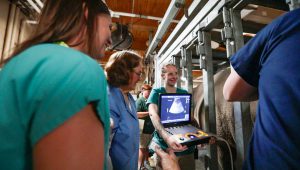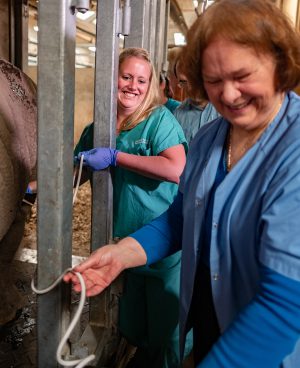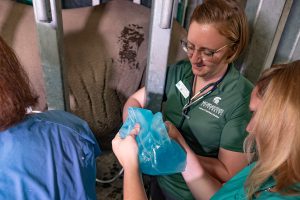For the first time, there’s a pregnant black rhino at the Potter Park Zoo in Lansing, Michigan—and veterinarians and students from the Michigan State University College of Veterinary Medicine and Veterinary Medical Center are working with Potter Park Zoo to monitor, learn from, and plan for the pregnancy.

Doppsee, the first-time expectant rhino mother, came to Potter Park Zoo from Kansas in 2011. Since then, zookeepers have been preparing her to be bred. As an active participant in the Species Survival Plan (SSP), Potter Park Zoo receives breeding and transfer recommendations for rhinos across the country that are located in Association-of-Zoos-and-Aquariums- (AZA) accredited facilities. With a mission to oversee the population management of select species and to enhance the conservation of this species in the world, the SSP’s recommendations are very important.
“The AZA is doing great work for black rhino conservation,” says Dr. Ronan Eustace, director of animal health for Potter Park Zoo. “Conservation is a priority for AZA-accredited zoos, and a key part of their missions. Potter Park Zoo is honored to be a part of that work.”
While Potter Park Zoo waited to receive a breeding recommendation for Doppsee, zookeepers and veterinary staff worked with Dr. Monica Stoops, a researcher from the Lindner Center for Conservation and Research of Endangered Wildlife (CREW), to study and develop an understanding of her hormone levels, estrus cycle, and behavior. By doing this, they were able to predict her estrus cycle (every 23.6 days), which in turn tells them exactly when her body is ready to mate, and possibly conceive a rhino calf, each month. In April of 2017, that recommendation came: Phineus, a nine-year-old male black rhino from a zoo in Texas.
Match.com for wildlife: how Doppsee met Phineus

Doppsee and Phineus’ relationship didn’t begin with love at first sight. In fact, rhinos don’t really work that way at all. Courtship between rhinos often is aggressive, calculated, and can be complicated. They spar, chase, and sometimes stampede at one another. The male hasn’t won the affection of the female until she allows him to rest his head on her rump. And even then, she may deny his efforts.
Breeding pairs stay together for as little as two–three days or as long as a few weeks, and they mate several times a day. Mating doesn’t normally exceed more than 30 minutes, after which the male and female go their separate ways. In Phineus and Doppsee’s case, this means they return to their own separate homes at the zoo.
“Before breeding between Phineus and Doppsee even began, zoo staff and the veterinary department worked diligently to make sure it would be safe for all animals and people involved,” says Cynthia Wagner, director of Potter Park Zoo and alumna of MSU. “The zoo community as a whole has been working together to understand the breeding and reproduction process of rhinos. Potter Park Zoo is very fortunate to foster an environment where we could introduce, monitor, and mate Doppsee and Phineus,” says Wagner.

Despite mating multiple times, zookeepers were uncertain if Doppsee was indeed pregnant. Physical signs of rhino pregnancy aren’t visible until right before birth. While there are some minor behavior and physical changes that zookeepers and veterinarians know to look for, such as the slight swelling of the female’s mammary glands, these types of pregnancy cues are difficult to see and aren’t always reliable.
Ultrasound and hormone level measurement are two reliable methods veterinarians can use to determine pregnancy. To test hormone levels, specifically progesterone, blood, fecal and urine samples are needed. “The hours animal care and veterinary staff have spent training Doppsee have made it possible for us to perform each kind of test we need to,” says Eustace.
As part of an ongoing study on reproduction in captive black rhinos, blood, urine, and fecal samples were sent to CREW to confirm Doppsee’s pregnancy. Eustace, and Dr. Julie Strachota and Dr. Carla Carleton from the MSU College of Veterinary Medicine, also confirmed pregnancy through multiple ultrasound evaluations.
Doppsee is expected to give birth in December of 2019.
Eating sweet potatoes and alfalfa for two: the importance of Doppsee’s pregnancy

Doppsee’s pregnancy isn’t only significant because black rhinos are classified as critically endangered; Doppsee has very valuable genetics in the captive population of eastern black rhinos. The more these genetics can be spread, the greater chance there is of preserving the black rhino species. For the first time, MSU veterinarians and veterinary students are able to play an active role in not only aiding in this preservation, but in learning how to help future black rhino pregnancies be successful.
Also, of significance is Doppsee’s attitude. “She isn’t like most rhinos,” says Eustace, “using only positive reinforcement—in the form of her favorite foods—we’ve been able to train Doppsee for abdominal and rectal ultrasounds, blood draws, and exams.”
For example, in order for Eustace, Carleton, and Strachota to ultrasound Doppsee, she must enter a chute. Every time she enters the chute, the back-door closes and the front door remains open. This allows the veterinarians and the zookeepers to safely work behind her, and also allows Doppsee to exit the chute whenever she pleases. While the ultrasound is being performed, Doppsee receives sweet potato and alfalfa hay treats. Due to the success of Potter Park Zoo’s training, Doppsee rarely leaves the chute when she’s being examined. “The importance of positive reinforcement can’t be understated. In addition, it’s important that Doppsee’s participation is always voluntary,” says Eustace.

“Through Doppsee’s excellent attitude and the patience and diligence of zoo staff, veterinarians, and veterinary students, we’ve been able to provide Doppsee with intimate care, which only benefits her and her unborn calf. We couldn’t be prouder of Doppsee, or of our relationship with MSU,” says Eustace.
The value of being able to expose veterinary medical students to exotic species, especially those that students don’t normally get to work with, can’t be overstated. “Dr. Eustace always welcomes us to bring as many students as we can to work with the animals at Potter Park Zoo,” says Strachota. “During one of our ultrasound examinations, one of the senior students that I took to see Doppsee commented that it was ‘the best day of veterinary school.’ What Potter Park Zoo is doing for our veterinary curriculum is invaluable.”
For more than 40 years, the College has been partnered with Potter Park Zoo on the shared mission to provide excellent animal welfare to wildlife and exotic animals at zoos, preserve our ecosystem, and train the next generation of veterinarians.

"Collaborating with Potter Park Zoo is a wonderful educational experience, not only for our veterinarians, but for our veterinary medical students,” says Strachota. “I never would’ve expected that I would be doing transrectal and transabdominal ultrasounds on a black rhino as part of my training to become a theriogenologist.”
Veterinarians and zookeepers continue to monitor Doppsee and her fetus weekly, always providing opportunities for students from the College to practice their physical exam, blood draw, and ultrasound skills on Doppsee. And most importantly, ensuring that she and her baby calf are safe, happy, and healthy.
*The AZA is a non-profit organization dedicated to the advancement of zoos and aquariums in the areas of conservation, education, science, and recreation.
*Work with Dr. Monica Stoops and the Lindner Center for Conservation and Research of Endangered Wildlife (CREW): Zookeepers helped with the training of Doppsee and collection of some of the samples (urine and feces). The veterinary staff collected blood samples and also coordinated shipping, processing, storing, and sending samples. Neither department (MSU or PPZ) did the actual research, we just collaborated with Dr. Stoops’ project, which is a large multi-institutional collaborative project.
*Julie Strachota, DVM, MS, clinical instructor for the Department of Large Animal Clinical Sciences and resident for the Large Animal Theriogenology Service.
*Carla L. Carleton, DVM, MS, DACT, DACAW, professor emeritus for the Department of Large Animal Clinical Sciences
